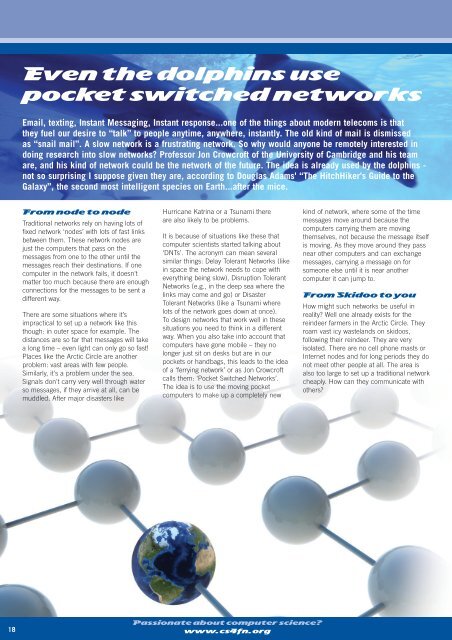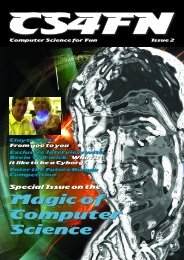a pdf version - cs4fn
a pdf version - cs4fn
a pdf version - cs4fn
Create successful ePaper yourself
Turn your PDF publications into a flip-book with our unique Google optimized e-Paper software.
Even the dolphins usepocket switched networksEmail, texting, Instant Messaging, Instant response...one of the things about modern telecoms is thatthey fuel our desire to “talk” to people anytime, anywhere, instantly. The old kind of mail is dismissedas “snail mail”. A slow network is a frustrating network. So why would anyone be remotely interested indoing research into slow networks? Professor Jon Crowcroft of the University of Cambridge and his teamare, and his kind of network could be the network of the future. The idea is already used by the dolphins -not so surprising I suppose given they are, according to Douglas Adams' “The HitchHiker's Guide to theGalaxy”, the second most intelligent species on Earth...after the mice.From node to nodeTraditional networks rely on having lots offixed network ‘nodes’ with lots of fast linksbetween them. These network nodes arejust the computers that pass on themessages from one to the other until themessages reach their destinations. If onecomputer in the network fails, it doesn'tmatter too much because there are enoughconnections for the messages to be sent adifferent way.There are some situations where it’simpractical to set up a network like thisthough: in outer space for example. Thedistances are so far that messages will takea long time – even light can only go so fast!Places like the Arctic Circle are anotherproblem: vast areas with few people.Similarly, it's a problem under the sea.Signals don't carry very well through waterso messages, if they arrive at all, can bemuddled. After major disasters likeHurricane Katrina or a Tsunami thereare also likely to be problems.It is because of situations like these thatcomputer scientists started talking about‘DNTs’. The acronym can mean severalsimilar things: Delay Tolerant Networks (likein space the network needs to cope witheverything being slow), Disruption TolerantNetworks (e.g., in the deep sea where thelinks may come and go) or DisasterTolerant Networks (like a Tsunami wherelots of the network goes down at once).To design networks that work well in thesesituations you need to think in a differentway. When you also take into account thatcomputers have gone mobile – they nolonger just sit on desks but are in ourpockets or handbags, this leads to the ideaof a ‘ferrying network’ or as Jon Crowcroftcalls them: ‘Pocket Switched Networks’.The idea is to use the moving pocketcomputers to make up a completely newkind of network, where some of the timemessages move around because thecomputers carrying them are movingthemselves, not because the message itselfis moving. As they move around they passnear other computers and can exchangemessages, carrying a message on forsomeone else until it is near anothercomputer it can jump to.From Skidoo to youHow might such networks be useful inreality? Well one already exists for thereindeer farmers in the Arctic Circle. Theyroam vast icy wastelands on skidoos,following their reindeer. They are veryisolated. There are no cell phone masts orInternet nodes and for long periods they donot meet other people at all. The area isalso too large to set up a traditional networkcheaply. How can they communicate withothers?18Passionate about computer science?www.<strong>cs4fn</strong>.org





